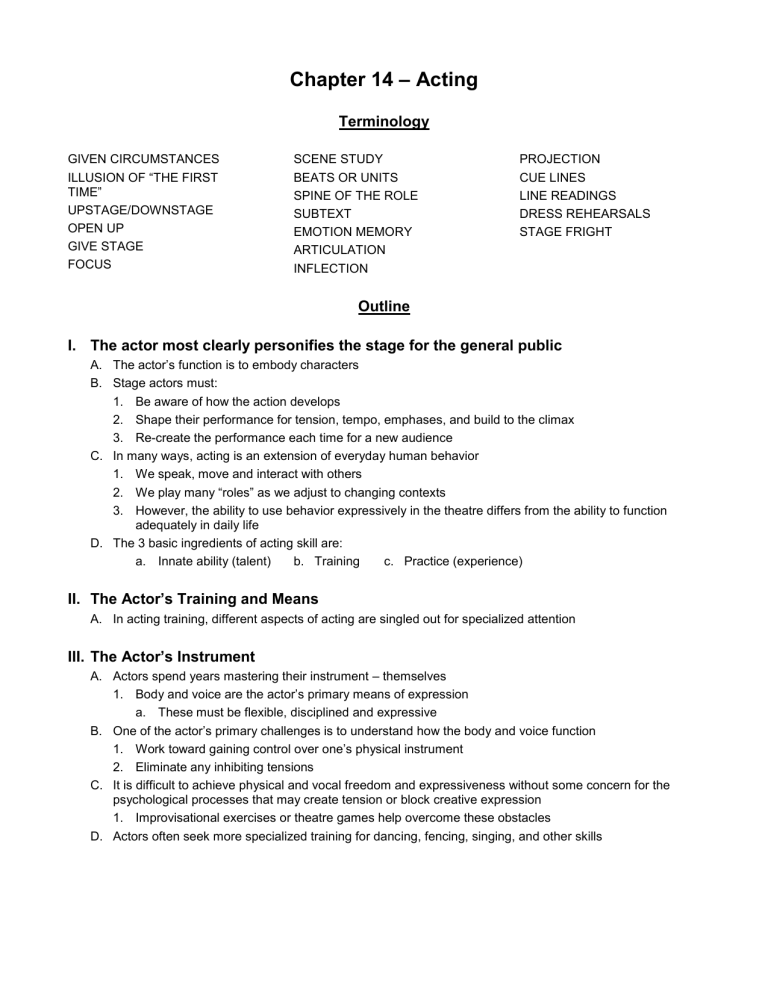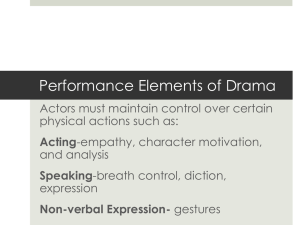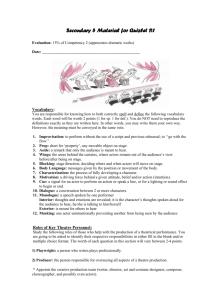– Acting Chapter 14 Terminology

Chapter 14
– Acting
Terminology
GIVEN CIRCUMSTANCES
ILLUSION OF “THE FIRST
TIME”
UPSTAGE/DOWNSTAGE
OPEN UP
GIVE STAGE
FOCUS
SCENE STUDY
BEATS OR UNITS
SPINE OF THE ROLE
SUBTEXT
EMOTION MEMORY
ARTICULATION
INFLECTION
PROJECTION
CUE LINES
LINE READINGS
DRESS REHEARSALS
STAGE FRIGHT
Outline
I. The actor most clearly personifies the stage for the general public
A. The actor’s function is to embody characters
B. Stage actors must:
1. Be aware of how the action develops
2. Shape their performance for tension, tempo, emphases, and build to the climax
3. Re-create the performance each time for a new audience
C. In many ways, acting is an extension of everyday human behavior
1. We speak, move and interact with others
2. We play many “roles” as we adjust to changing contexts
3. However, the ability to use behavior expressively in the theatre differs from the ability to function adequately in daily life
D. The 3 basic ingredients of acting skill are: a. Innate ability (talent) b. Training c. Practice (experience)
II. The Actor’s Training and Means
A. In acting training, different aspects of acting are singled out for specialized attention
III.
The Actor’s Instrument
A. Actors spend years mastering their instrument – themselves
1. Body and voice are the actor’s primary means of expression a. These must be flexible, disciplined and expressive
B. One of the actor’s primary challenges is to understand how the body and voice function
1. Work toward gaining control over one’s physical instrument
2. Eliminate any inhibiting tensions
C. It is difficult to achieve physical and vocal freedom and expressiveness without some concern for the psychological processes that may create tension or block creative expression
1. Improvisational exercises or theatre games help overcome these obstacles
D. Actors often seek more specialized training for dancing, fencing, singing, and other skills
BOX – Actors’ Thoughts on Acting
Here are a few excerpts of well-known actors talking about their work:
Willem Dafoe: “I think that all the characters I play are basically me.”
John Barrymore: “Acting is…doing and saying the thing as spontaneously as if you were confronted with the situation in which you were acting for the first time.”
Joseph Chaikin: “the most essential acting dimension – that of being there and inhabiting the play as it’s performed.”
Fiona Shaw: “the key being one’s own grief that reveals a very dark pool of basic grief that everybody has.”
Judy Dench: “I like being in a repertoire of 4 or 5 plays….You’re kept very much on your toes.”
IV. Observation and Imagination
A. Actors need to develop the habit of watching other people
B. Actors must also develop imagination in order to “feel their way” into the lives of others and into fictional situations
1. Identify the given circumstances
2. Particularize objects with the properties of real ones
3. Endow objects, places and people with the emotional significance and value they have for the character
V. Concentration
A. Actors must also learn to control, shape and integrate their basic skills as the script and the director demand
BOX – Lee Strasberg on the Role of Imagination
Here are some of his thoughts on the necessity of actors to project themselves into the fictional situation:
“The actor must constantly respond to stimuli which are imaginary. And yet this must not happen only just as it happens in life, but actually more fully and expressively.”
“He must somehow believe. He must somehow be able to convince himself of the rightness of what he is doing in order to do things fully on the stage.”
B. One mark of control and discipline is concentration
1. The ability to shut out all distractions
2. The ability to concentrate on present stimulus as it occurs to create the illus ion of “the first time”
VI. Stage Vocabulary
A. Many routine tasks have been reduced to a set of conventions that actors are expected to know
B. Among the basic conventions is the division of the stage into areas
1. Upstage
2. Downstage
3. Stage right and stage left
4. Up right, up center, up left
5. Right, center, left
6. Down right, down center, down left
C. The actor is also expected to be familiar with body positions as they relate to the audience
1. Full front, one-quarter, one-half, three-quarter, full back
D. Other terminology may supplement designations of area and bodily positions
1. Open up 2. Turn in, turn out 3. Share a scene
4. Give stage 5. Focus 6. Dress the stage
E. Some devices are used to emphasize or subordinate stage business
1. A “planted” prop
2. A masked, “cheated” or faked action
F. Actors normally strive to be graceful
1. Movement should be precise and clear
2. The more actors know about other aspects of production the better they will be able to utilize these elements in their acting
VII. Creating a role
A. The most basic task of acting is to understand the role
1. Levels of characterization a. Biological b. Sociological c. Psychological
B. It is helpful to determine which traits are necessary within the dramatic action
C. The actor needs to understand the “spine” of the role d. Ethical a. What the character wants b. What the character is willing to do to get it c. How these are manifested in each scene, beat by beat, and how they develop throughout the play
D. Actors also need to examine how their roles relate to the others in the play
1. What does the character think of others?
2. How does the character present him or herself to other characters?
3. What does each of the others think of the character?
4. What is the function of each of these variations within the dramatic action?
E. The actor needs to understand the script in terms of its:
1. Themes
2. Implied meanings
3. Overall significance
4. Subtext
F. Actors need to examine their roles in relation to the director’s interpretation of the script
VIII. Psychological and Emotional Preparation
A. Actors must be able to project themselves imaginatively into the world of the play, its the specific situations and their characters’ feelings and motivations
1. Experiments with ways of inducing empathic involvement have yielded various methods a. Emotion memory b. Research and observe appropriate subjects c. Improvisation and theatre games
IX. Movement, Gesture and Business
A. Actors need to feel comfortable with their blocking and movement
B. The actor must fill in many details of the character’s movement
1. Physical characterization often involves a basic three-step process a. Consider physical traits required by the action b. Identify physical traits that may be dominate in any given beat c. Apply appropriate distinctiveness through greater specificity
X. Vocal Characterization
A. Actors may modify their vocal patterns considerably for purposes of characterization
1. Variable factors of voice a. Pitch b. Volume
2. Variable factors of speech c. Quality a. Articulation e. Audibility b. Pronunciation c. Duration f. Intelligible g. Variety d. Inflection
XIII. Memorization and Line Readings
A. It is helpful to memorize speech and movement simultaneously because they reinforce each other
B. Memorization is aided by a few simple procedures
1. Actors memorize their cues in connection with their lines
2. Actors study the meaning and purpose of their lines
3. Familiarity with the sequence of beats that make up each scene
4. Actors require repetition for memorization - even if it is provided by another simply holding a script copy and providing cues for the actor to repeat his or her lines over and over again
C. Actors form distinctive line readings through the controllable factors of voice and speech as filtered through an understanding of their characters
XIV. Dress Rehearsals and Performance
A. Actors are usually not able to work with all properties, settings, costumes, makeup and stage lighting until dress rehearsal(s)
B. Of special importance are the costumes and makeup
1. These alter appearance, movement and gesture
2. Rehearsal garments are often helpful to the performers a. They help the actors understand how they might use their costumes b. They help the actors understand how their costumes might affect their performances
3. The actors need to understand and be able to apply the makeup for their characters
C. Performance is the ultimate goal
1. Preparation equals confidence
2. Stage fright is common
3. Performers must guard against letdowns and mechanical performances - especially in long runs




